Assessment of Ecosystem Service Values of Urban Parks in Improving Air Quality: A Case Study of Wuhan, China
Abstract
:1. Introduction
2. Materials and Methods
2.1. Study Area
2.2. Land Cover Classification
2.3. Ecological Service Value Calculation
2.3.1. CO2 Sequestration
2.3.2. O2 Generation
2.3.3. Air Temperature Amelioration
2.3.4. SO2 Removal
2.3.5. NOx Removal
2.3.6. Dust Interception
3. Results
3.1. Park Composition
3.2. Ecological Service Values
3.3. Response of Ecological Service Values to Park Composition
4. Discussion
4.1. Necessity
4.2. Application
4.3. Limitation and Prospects
5. Conclusions
Author Contributions
Funding
Conflicts of Interest
Appendix A
| Park ID | CO2 Sequestration | O2 Generation | Air Temperature Amelioration | SO2 Removal | NOx Removal | Dust Interception | Total Value | ||||||
|---|---|---|---|---|---|---|---|---|---|---|---|---|---|
| Value | Percentage | Value | Percentage | Value | Percentage | Value | Percentage | Value | Percentage | Value | Percentage | ||
| 1 | 3,090,276 | 71.83 | 915,939 | 21.29 | 80,222 | 1.86 | 11,245 | 0.26 | 120,547 | 2.80 | 84,098 | 1.95 | 4,302,426 |
| 2 | 304,437 | 71.51 | 90,176 | 21.18 | 10,665 | 2.51 | 1305 | 0.31 | 11,084 | 2.60 | 8046 | 1.89 | 425,812 |
| 3 | 5,482,957 | 69.35 | 1,622,348 | 20.52 | 448,910 | 5.68 | 29,483 | 0.37 | 173,920 | 2.20 | 148,875 | 1.88 | 7,906,591 |
| 4 | 141,551 | 72.12 | 41,918 | 21.36 | 3555 | 1.81 | 642 | 0.33 | 5033 | 2.56 | 3577 | 1.82 | 196,375 |
| 5 | 240,763 | 71.89 | 71,354 | 21.31 | 6067 | 1.81 | 899 | 0.27 | 9307 | 2.78 | 6493 | 1.94 | 334,981 |
| 6 | 10,694,486 | 71.80 | 3,169,452 | 21.28 | 289,220 | 1.94 | 40,053 | 0.27 | 412,660 | 2.77 | 289,385 | 1.94 | 14,895,354 |
| 7 | 1,882,886 | 72.12 | 557,436 | 21.35 | 49,746 | 1.91 | 9069 | 0.35 | 64,849 | 2.48 | 46,609 | 1.79 | 2,610,694 |
| 8 | 3,979,627 | 71.47 | 1,179,357 | 21.18 | 132,515 | 2.38 | 15,101 | 0.27 | 152,552 | 2.74 | 108,879 | 1.96 | 5,568,129 |
| 9 | 1,633,224 | 71.48 | 483,964 | 21.18 | 54,713 | 2.39 | 6335 | 0.28 | 62,068 | 2.72 | 44,413 | 1.94 | 2,284,816 |
| 10 | 1,897,092 | 72.43 | 561,025 | 21.42 | 50,282 | 1.92 | 11,276 | 0.43 | 57,052 | 2.18 | 42,451 | 1.62 | 2,619,275 |
| 11 | 105,352 | 71.77 | 31,242 | 21.28 | 2566 | 1.75 | 325 | 0.22 | 4336 | 2.95 | 2979 | 2.03 | 146,899 |
| 12 | 207,301 | 72.05 | 61,405 | 21.34 | 5178 | 1.80 | 885 | 0.31 | 7584 | 2.64 | 5353 | 1.86 | 287,803 |
| 13 | 257,225 | 70.66 | 76,198 | 20.93 | 12,992 | 3.57 | 1080 | 0.30 | 9413 | 2.59 | 7104 | 1.95 | 364,110 |
| 14 | 869,847 | 71.95 | 257,561 | 21.30 | 25,091 | 2.08 | 4053 | 0.34 | 30,469 | 2.52 | 21,958 | 1.82 | 1,209,078 |
| 15 | 1,782,214 | 72.21 | 527,434 | 21.37 | 47,846 | 1.94 | 9271 | 0.38 | 58,714 | 2.38 | 42,715 | 1.73 | 2,468,292 |
| 16 | 1,058,295 | 72.28 | 313,202 | 21.39 | 26,942 | 1.84 | 5482 | 0.37 | 34,970 | 2.39 | 25,319 | 1.73 | 1,464,308 |
| 17 | 4,833,109 | 72.16 | 1,430,848 | 21.36 | 124,964 | 1.87 | 23,328 | 0.35 | 166,300 | 2.48 | 119,361 | 1.78 | 6,698,008 |
| 18 | 383,371 | 70.95 | 113,552 | 21.02 | 17,513 | 3.24 | 1659 | 0.31 | 13,859 | 2.56 | 10,364 | 1.92 | 540,417 |
| 19 | 2,302,328 | 72.10 | 681,685 | 21.35 | 60,536 | 1.90 | 10,842 | 0.34 | 80,259 | 2.51 | 57,497 | 1.80 | 3,193,245 |
| 20 | 692,797 | 72.08 | 205,177 | 21.35 | 17,608 | 1.83 | 3087 | 0.32 | 24,835 | 2.58 | 17,632 | 1.83 | 961,236 |
| 21 | 283,197 | 69.91 | 83,984 | 20.73 | 16,777 | 4.14 | 869 | 0.21 | 11,579 | 2.86 | 8657 | 2.14 | 405,161 |
| 22 | 258,827 | 71.85 | 76,720 | 21.30 | 6520 | 1.81 | 923 | 0.26 | 10,173 | 2.82 | 7071 | 1.96 | 360,332 |
| 23 | 116,353 | 71.77 | 34,505 | 21.28 | 2834 | 1.75 | 359 | 0.22 | 4788 | 2.95 | 3290 | 2.03 | 162,227 |
| 24 | 1,617,569 | 71.78 | 479,382 | 21.27 | 44,380 | 1.97 | 6079 | 0.27 | 62,329 | 2.77 | 43,768 | 1.94 | 2,253,605 |
| 25 | 4,841,938 | 71.94 | 1,434,550 | 21.31 | 125,702 | 1.87 | 19,598 | 0.29 | 181,212 | 2.69 | 127,586 | 1.90 | 6,730,684 |
| 26 | 465,169 | 70.95 | 137,779 | 21.01 | 21,324 | 3.25 | 2017 | 0.31 | 16,796 | 2.56 | 12,570 | 1.92 | 655,754 |
| 27 | 3,551,305 | 72.01 | 1,051,809 | 21.33 | 93,640 | 1.90 | 15,611 | 0.32 | 128,102 | 2.60 | 91,056 | 1.85 | 4,931,622 |
| 28 | 512,417 | 72.18 | 150,870 | 21.25 | 27,471 | 3.87 | 5351 | 0.75 | 6342 | 0.89 | 7491 | 1.06 | 710,041 |
| 29 | 4,763,146 | 72.09 | 1,410,503 | 21.35 | 123,067 | 1.86 | 21,715 | 0.33 | 168,835 | 2.56 | 120,324 | 1.82 | 6,607,687 |
| 30 | 3,875,449 | 72.48 | 1,145,616 | 21.43 | 107,043 | 2.00 | 24,649 | 0.46 | 110,257 | 2.06 | 83,590 | 1.56 | 5,346,702 |
| 31 | 6,899,971 | 71.63 | 2,042,699 | 21.21 | 245,946 | 2.55 | 33,450 | 0.35 | 236,183 | 2.45 | 174,461 | 1.81 | 9,632,807 |
| 32 | 1,682,112 | 71.77 | 498,835 | 21.28 | 40,975 | 1.75 | 5196 | 0.22 | 69,226 | 2.95 | 47,557 | 2.03 | 2,343,999 |
| 33 | 2,230,426 | 71.77 | 661,439 | 21.28 | 54,331 | 1.75 | 6890 | 0.22 | 91,791 | 2.95 | 63,059 | 2.03 | 3,108,034 |
| 34 | 765,637 | 70.91 | 226,248 | 20.95 | 44,788 | 4.15 | 5146 | 0.48 | 20,478 | 1.90 | 17,458 | 1.62 | 1,079,853 |
| 35 | 1,010,351 | 71.02 | 299,624 | 21.06 | 38,657 | 2.72 | 3113 | 0.22 | 41,472 | 2.92 | 29,490 | 2.07 | 1,422,805 |
| 36 | 1,865,372 | 72.05 | 552,563 | 21.34 | 46,564 | 1.80 | 7904 | 0.31 | 68,462 | 2.64 | 48,285 | 1.86 | 2,589,248 |
| 37 | 983,218 | 71.64 | 291,205 | 21.22 | 32,738 | 2.39 | 4322 | 0.31 | 35,399 | 2.58 | 25,650 | 1.87 | 1,372,631 |
| 38 | 1,583,252 | 72.32 | 468,489 | 21.40 | 40,440 | 1.85 | 8457 | 0.39 | 51,326 | 2.34 | 37,347 | 1.71 | 2,189,408 |
| 39 | 469,788 | 72.98 | 138,649 | 21.54 | 12,659 | 1.97 | 3765 | 0.58 | 10,359 | 1.61 | 8470 | 1.32 | 643,789 |
| 40 | 1,731,614 | 73.77 | 509,513 | 21.71 | 49,466 | 2.11 | 19,216 | 0.82 | 17,473 | 0.74 | 20,117 | 0.86 | 2,347,498 |
References
- Tzoulas, K.; Korpela, K.; Venn, S.; Yli-Pelkonen, V.; Kaz’miercak, A.; Niemela, J.; James, P. Promoting ecosystem and human health in urban areas using greens pace infrastructure: A literature review. Landsc. Urban Plan. 2007, 81, 167–178. [Google Scholar] [CrossRef]
- Zupancic, T.; Westmacott, C.; Bulthuis, M. The Impact of Green Space on Heat and Air Pollution in Urban Communities: A Meta-Narrative Systematic Review; David Suzuki Foundation: Vancouver, BC, Canada, 2015. [Google Scholar]
- Stone, B. Urban sprawl and air quality in large US cities. J. Environ. Manag. 2008, 86, 688–698. [Google Scholar] [CrossRef]
- Carpentieri, M.; Robins, A.G. Influence of urban morphology on air flow over building arrays. J. Wind. Eng. Ind. Aerodyn. 2015, 145, 61–74. [Google Scholar] [CrossRef]
- Huang, J.; Li, F.; Zeng, G.; Liu, W.; Huang, X.; Xiao, Z.; Wu, H.; Gu, Y.; Li, X.; He, X.; et al. Integrating hierarchical bioavailability and population distribution into potential eco-risk assessment of heavymetals in road dust: A case study in Xiandao District, Changsha city, China. Sci. Total Environ. 2016, 541, 969–976. [Google Scholar] [CrossRef]
- Zeng, J.; Liu, Y.; Feiock, R.; Li, F. The impacts of China’s provincial energy policies on major air pollutants: A spatial econometric analysis. Energy Policy 2019, 132, 392–403. [Google Scholar] [CrossRef]
- Ding, Y.; Li, G.C.; Lu, X.; Gao, M. Spatial Heterogeneity and Air Pollution Removal by Green Space in Greater Pearl River Delta. Prog. Geogr. 2011, 30, 1415–1421. [Google Scholar]
- Jayasooriya, V.; Ng, A.; Muthukumaran, S.; Perera, B. Green infrastructure practices for improvement of urban air quality. Urban For. Urban Green. 2017, 21, 34–47. [Google Scholar] [CrossRef]
- Liu, H.; Li, F.; Xu, L.; Han, B. The impact of socio-demographic, environmental, and individual factors on urban park visitation in Beijing, China. J. Clean. Prod. 2017, 163, S181–S188. [Google Scholar] [CrossRef]
- Pietrzyk-Kaszy´nska, N.; Czepkiewicz, M.; Kronenberg, J. Eliciting non-monetary values of formal and informal urban green spaces using public participation GIS. Landsc. Urban Plan. 2017, 160, 85–95. [Google Scholar] [CrossRef]
- Cohen, P.; Potchter, O.; Schnell, I. A methodological approach to the environmental quantitative assessment of urban parks. Appl. Geogr. 2014, 48, 87–101. [Google Scholar] [CrossRef]
- Vieira, J.; Matos, P.; Mexia, T.; Silva, P.; Lopes, N.; Freitas, C.; Correia, O.; Santos-Reis, M.; Branquinho, C.; Pinho, P. Green spaces are not all the same for the provision of air purification and climate regulation services: The case of urban parks. Environ. Res. 2018, 160, 306–313. [Google Scholar] [CrossRef] [PubMed]
- McDonald, A.; Bealey, W.; Fowler, D.; Dragosits, U.; Skiba, U.; Smith, R.; Donovan, R.; Brett, H.; Hewitt, C.N.; Nemitz, E. Quantifying the effect of urban tree planting on concentrations and depositions of PM10 in two UK conurbations. Atmos. Environ. 2007, 41, 8455–8467. [Google Scholar] [CrossRef]
- Cavanagh, J.A.E.; Zawar-Reza, P.; Wilson, J.G. Spatial attenuation of ambient particulate matters air pollution within an urbanized native forest patch. Urban For. Urban Green. 2009, 8, 21–30. [Google Scholar] [CrossRef]
- Yin, S.; Shen, Z.; Zhou, P.; Zou, X.; Che, S.; Wang, W. Quantifying air pollution attenuation within urban parks: An experimental approach in Shanghai, China. Environ. Pollut. 2011, 159, 2155–2163. [Google Scholar] [CrossRef] [PubMed]
- Xie, Q.; Zhou, Z.; Chen, F. Quantifying the Beneficial Effect of Different Plant Species in Improving Air Quality. Environ. Eng. Manag. J. 2011, 10, 959–963. [Google Scholar]
- Mexia, T.; Vieira, J.; Príncipe, A.; Anjos, A.; Silva, P.; Lopes, N.; Freitas, C.; Santos-Reis, M.; Correia, O.; Branquinho, C.; et al. Ecosystem services: Urban parks under a magnifying glass. Environ. Res. 2018, 160, 469–478. [Google Scholar] [CrossRef]
- Davies, Z.G.; Edmondson, J.L.; Heinemeyer, A.; Leake, J.R.; Gaston, K.J. Mapping an urban ecosystem service: Quantifying above-ground carbon storage at a city-wide scale. J. Appl. Ecol. 2011, 48, 1125–1134. [Google Scholar] [CrossRef]
- Senanayake, I.; Welivitiya, W.; Nadeeka, P. Urban green spaces analysis for development planning in Colombo, Sri Lanka, utilizing THEOS satellite imagery—A remote sensing and GIS approach. Urban For. Urban Green. 2013, 12, 307–314. [Google Scholar] [CrossRef]
- Karagulian, F.; Belis, C.A.; Dora, C.F.C.; Prüss-Ustün, A.M.; Bonjour, S.; Adair-Rohani, H.; Amann, M. Contributions to cities’ ambient particulate matter (PM): A systematic review of local source contributions at global level. Atmos. Environ. 2015, 120, 475–483. [Google Scholar] [CrossRef]
- Ileperuma, O.A. Environmental pollution in Sri Lanka: A review. J. Natl. Sci. Found. Sri Lanka. 2010, 28, 301–325. [Google Scholar] [CrossRef]
- Chen, F.; Zhou, Z.X.; Xiao, R.B.; Wang, P.C.; Li, H.F.; Guo, E.X. Estimation of ecosystem services of urban green-land in the workshop area of the Wuhan Iron and Steel Company. Acta Ecol. Sin. 2006, 26, 2229–2236. [Google Scholar]
- Wang, F.Z. Evaluation on the Ecosystem Services Values of Urban Lake Wetlands: A Case Study of Urban Lake in Wuhan City. Ph.D. Thesis, Huazhong Agriculture University, Wuhan, China, 2010. [Google Scholar]
- Kong, D.S.; Zhang, H. Economic value of wetland ecosystem services in the Heihe National Nature Reserve of Zhangye. Acta Ecol. Sin. 2015, 35, 972–983. [Google Scholar]
- Price Bureau. 2018. Available online: http://wh.bendibao.com/live/2019529/99151.shtm (accessed on 10 November 2019).
- Jin, F.; Lu, S.W.; Yu, X.X.; Rao, L.Y.; Niu, J.Z.; Xie, Y.Y.; Zhang, Z.M. Forest ecosystem service and its evaluation in China. Chin. J. Appl. Decol. 2005, 16, 1531–1536. [Google Scholar]
- Han, Y.; Zhou, Z. Evaluation on ecosystem services in haze absorption by urban green land and its spatial pattern analysis in Xi’an. Geogr. Res. 2015, 34, 1247–1258. [Google Scholar]
- Peng, J.; Wang, Y.L.; Chen, Y.F.; Li, W.F.; Jiang, Y.Y. Economic Value of Urban Ecosystem Services: A Case Study in S hen zhen. Acta Sci. Nat. Univ. Pekin. 2005, 41, 594–604. [Google Scholar]
- Duan, Y.B.; Lei, Y.K.; Wu, B.J.; Peng, D.D.; Tian, G.X. Evaluation and dynamic study on the ecological service value for urban green space system in Zhengzhou. Ecol. Sci. 2016, 35, 81–88. [Google Scholar]
- Zhang, X.L.; Xu, Z.J.; Zhang, Z.H.; Gu, D.Q.; Wang, L.H. Environment purification service value of urban green space ecosystem in Qingdao City. Acta Ecol. Sin. 2011, 31, 2576–2584. [Google Scholar]
- Xu, H.; Liu, X.Y.; An, Z.S.; Hou, Z.H.; Dong, J.B.; Liu, B. Spatial pattern of modern sedimentation rate of Qinghai lake and a preliminary estimate of the sediment flux. Chin. Sci. Bull. 2010, 55, 384–390. [Google Scholar] [CrossRef]
- Li, H.; Meier, F.; Lee, X.; Chakraborty, T.; Liu, J.; Schaap, M.; Sodoudi, S. Interaction between urban heat island and urban pollution island during summer in Berlin. Sci. Total Environ. 2018, 636, 818–828. [Google Scholar] [CrossRef]
- Zhou, C.S.; Li, S.J.; Wang, S.J. Examining the Impacts of Urban Form on Air Pollution in Developing Countries: A Case Study of China’s Megacities. Int. J. Environ. Res. Public Health 2018, 15, 1565. [Google Scholar] [CrossRef]
- Tan, P.Y.; Samsudin, R. Effects of spatial scale on assessment of spatial equity of urban park provision. Landsc. Urban Plan. 2017, 158, 139–154. [Google Scholar] [CrossRef]
- Rigolon, A.; Browning, M.; Jennings, V. Inequities in the quality of urban park systems: An environmental justice investigation of cities in the United States. Landsc. Urban Plan. 2018, 178, 156–169. [Google Scholar] [CrossRef]
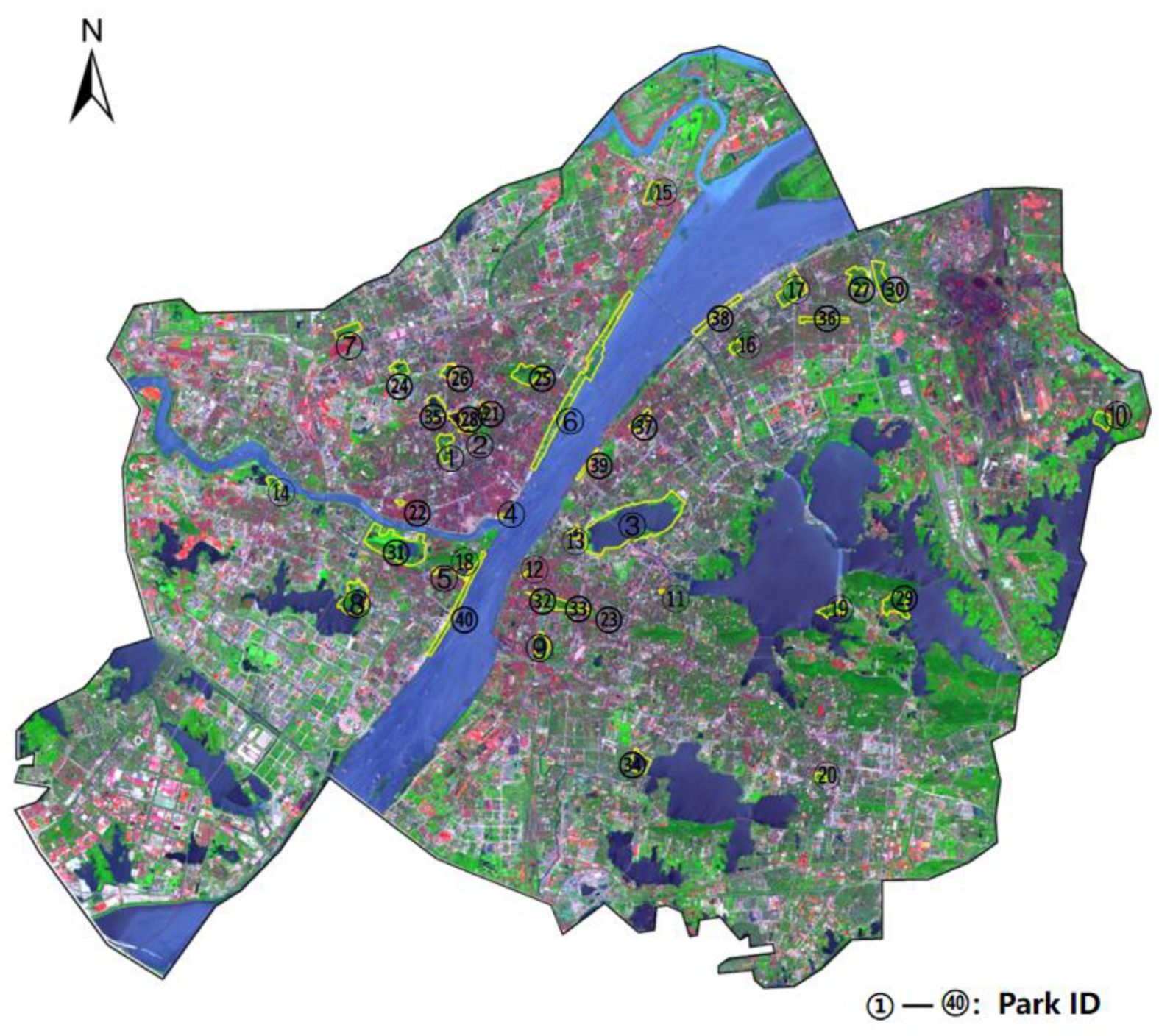
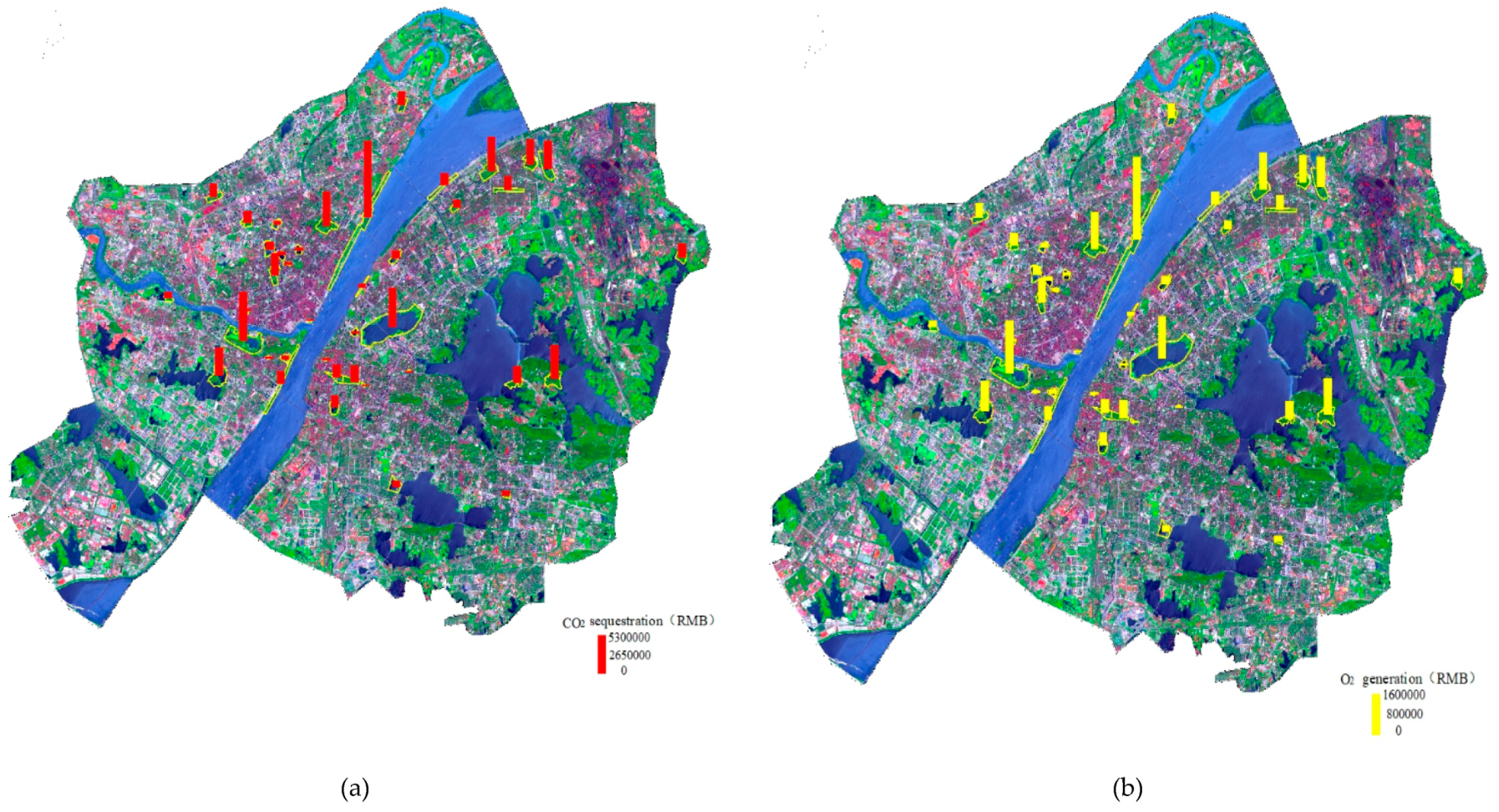
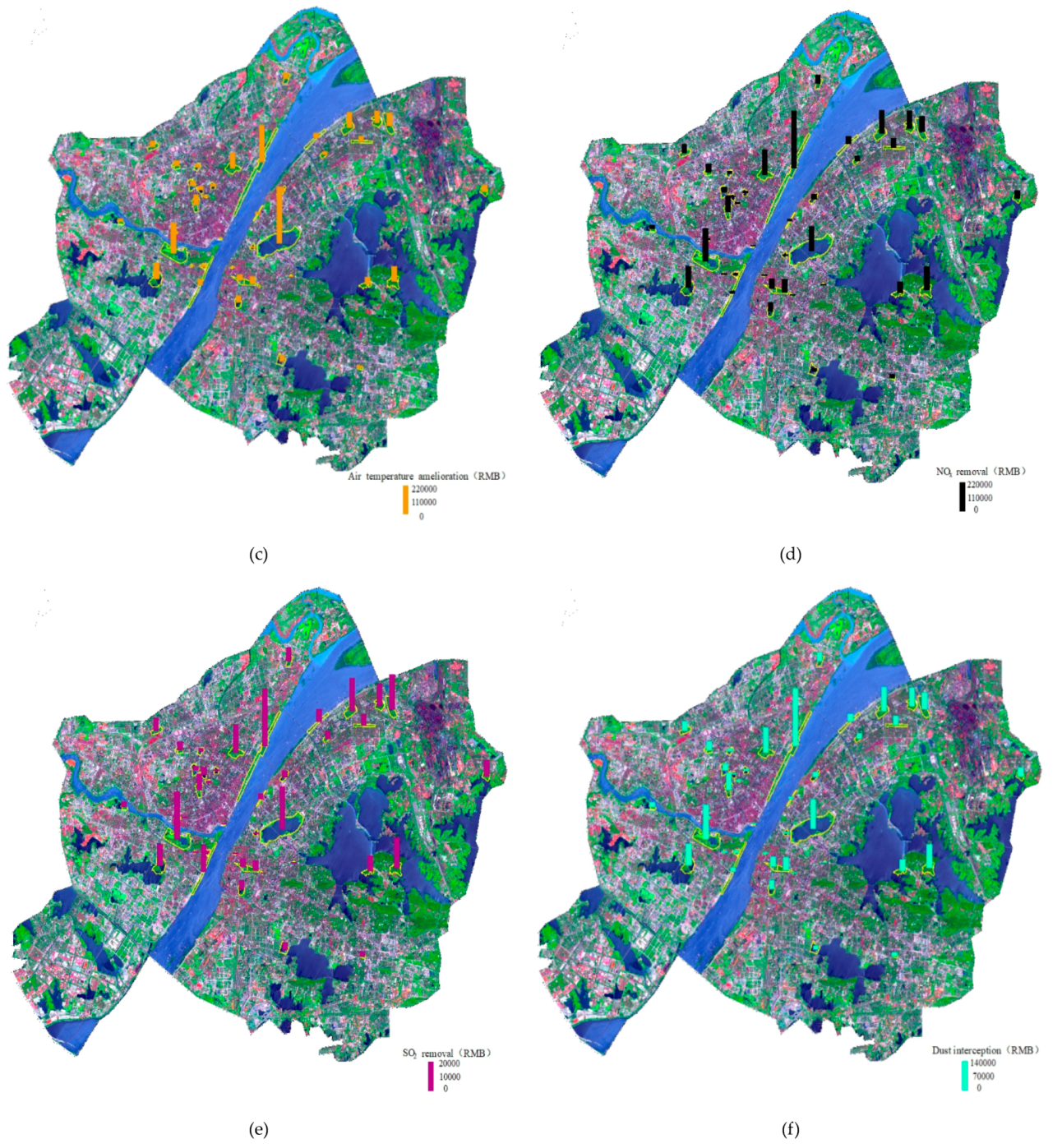
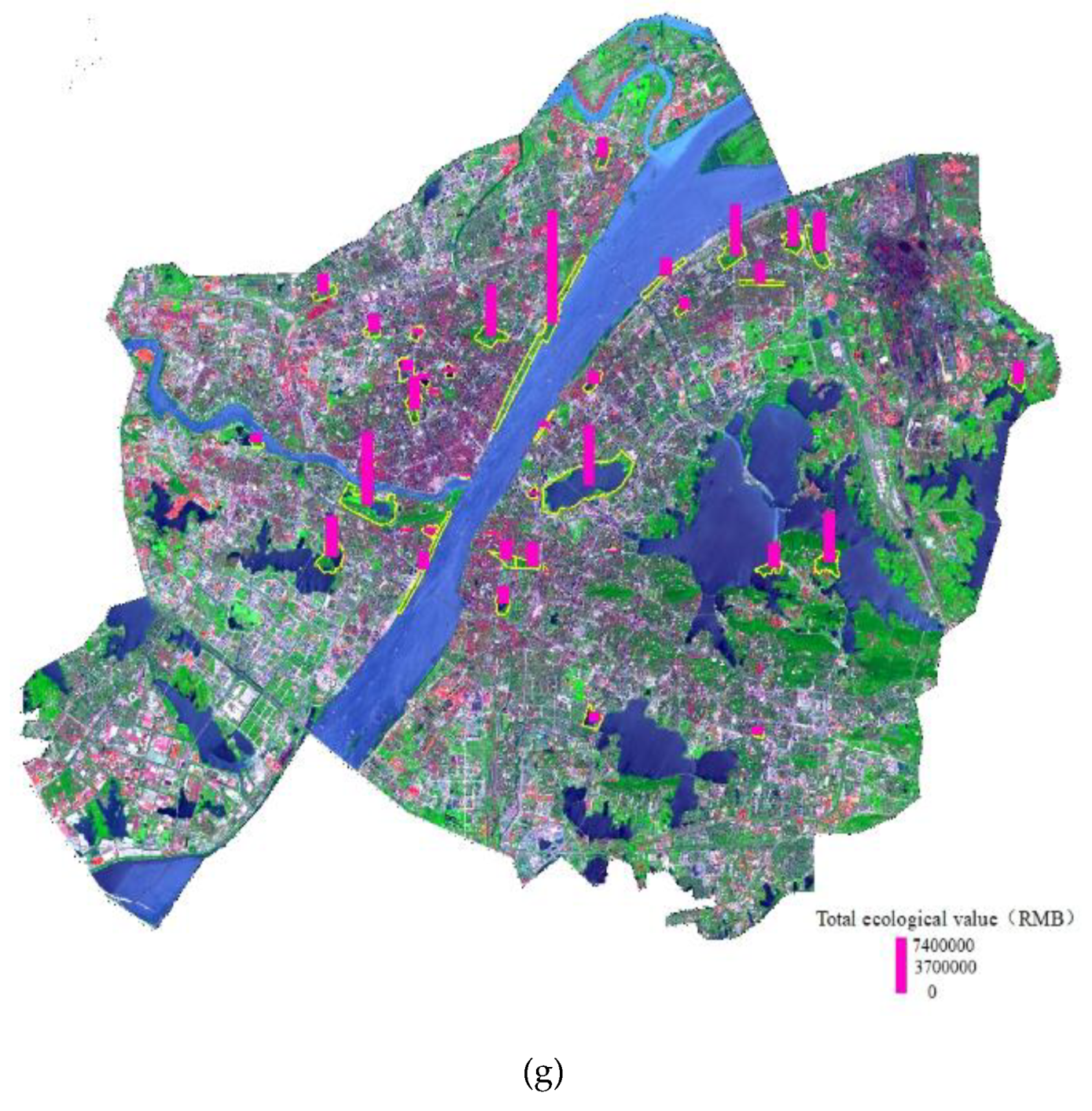
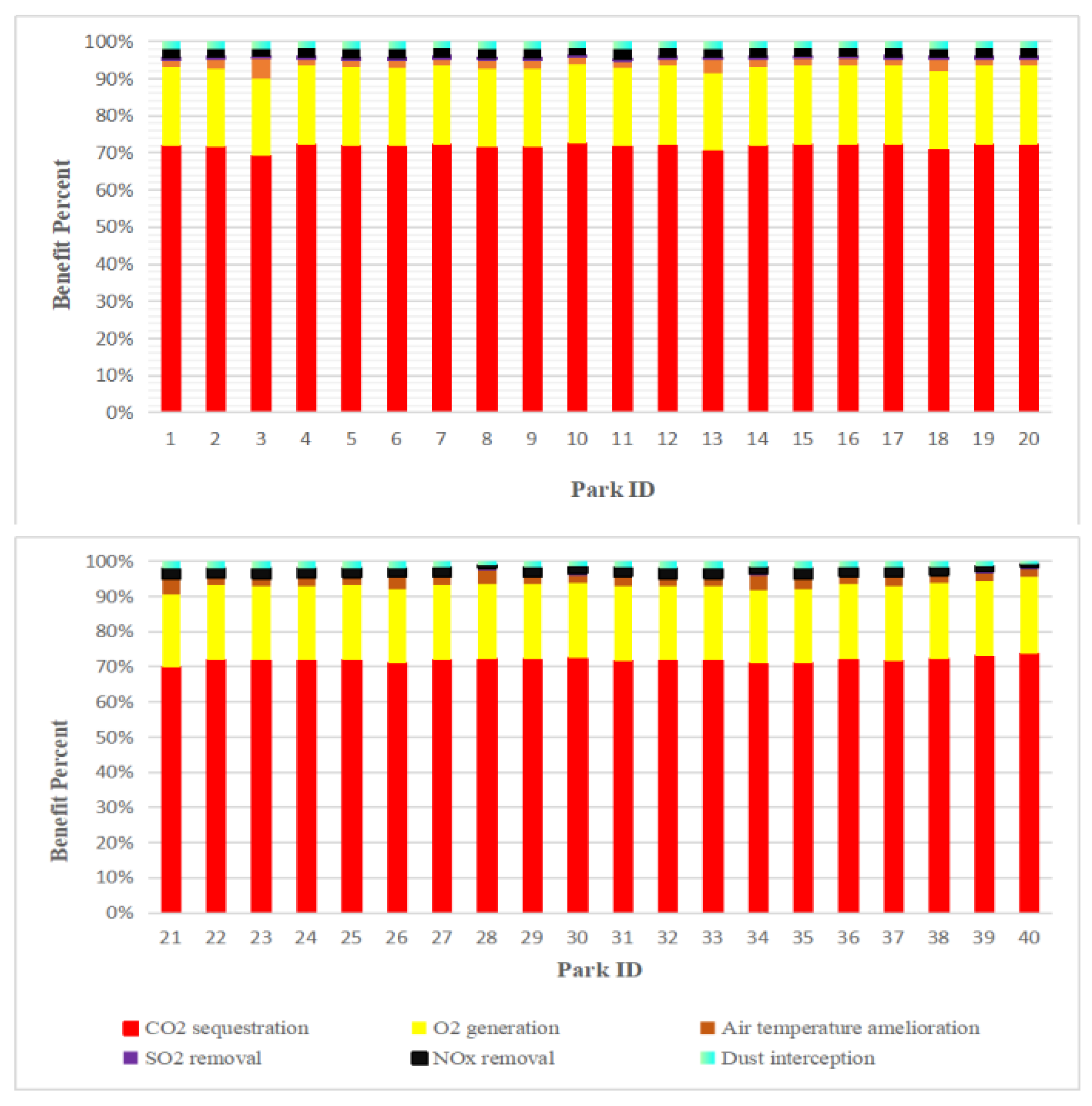

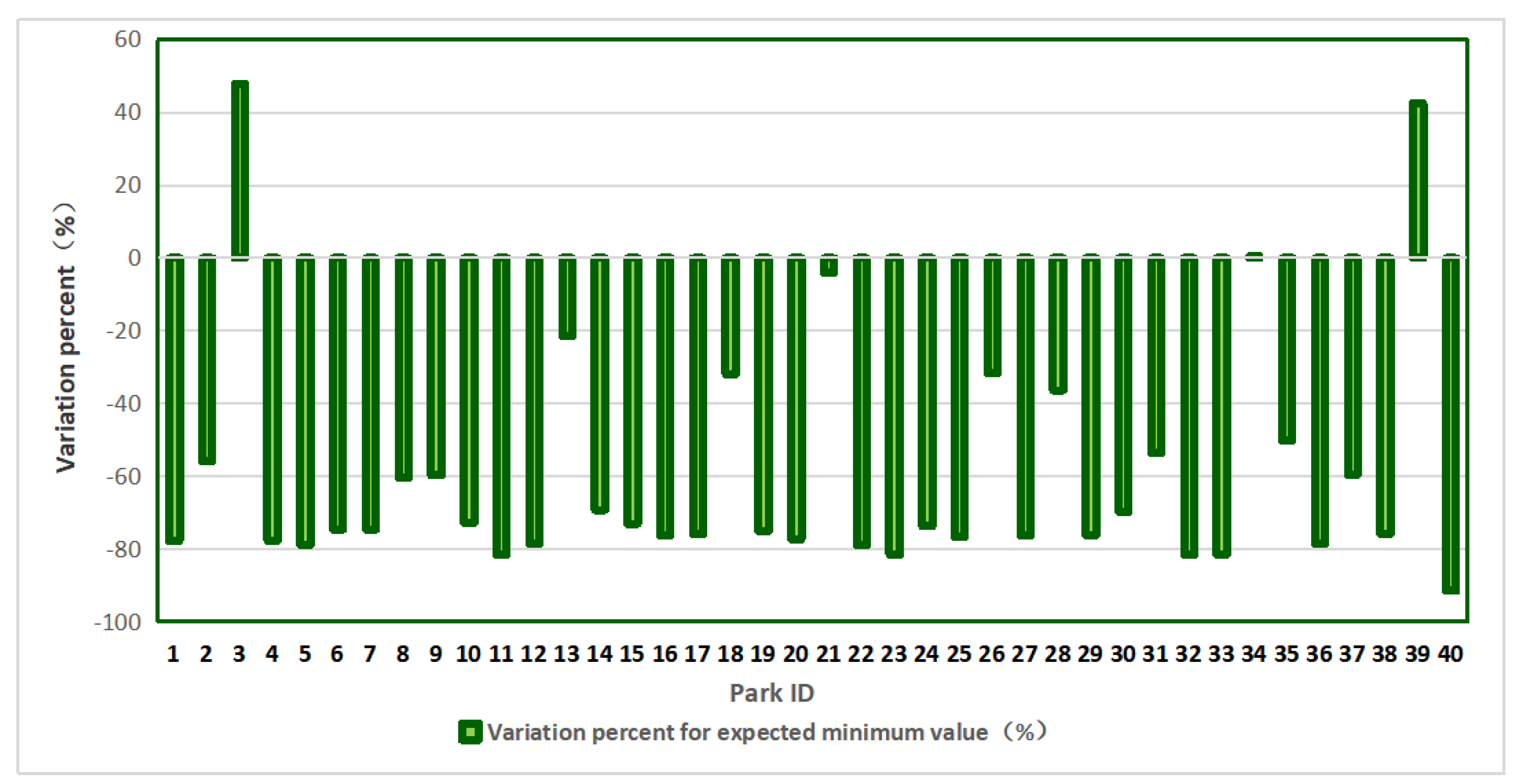
| Park ID | Park Name | Total Area (hm2) | Forest | Lawn | Water | Built-up | ||||
|---|---|---|---|---|---|---|---|---|---|---|
| Area (hm2) | Percentage | Area (hm2) | Percentage | Area (hm2) | Percentage | Area (hm2) | Percentage | |||
| 1 | Zhongshan | 30.49 | 19.15 | 62.83% | 2.56 | 8.40% | 3.40 | 11.16% | 5.37 | 17.61% |
| 2 | Xiaonanhu | 6.05 | 1.81 | 29.93% | 0.57 | 9.39% | 2.57 | 42.40% | 1.11 | 18.27% |
| 3 | Sha Lake | 324.62 | 28.21 | 8.69% | 19.73 | 6.08% | 259.26 | 79.87% | 17.42 | 5.37% |
| 4 | Longwangmiao | 1.92 | 0.83 | 43.31% | 0.32 | 16.74% | 0.00 | 0.00% | 0.77 | 39.96% |
| 5 | Hanyang | 2.23 | 1.53 | 68.62% | 0.24 | 10.80% | 0.10 | 4.58% | 0.36 | 16.00% |
| 6 | Hankou Beach | 147.13 | 67.70 | 46.01% | 10.94 | 7.43% | 21.01 | 14.28% | 47.48 | 32.27% |
| 7 | Changqing | 23.86 | 10.59 | 44.37% | 5.06 | 21.22% | 1.82 | 7.64% | 6.39 | 26.77% |
| 8 | Wuhan Zoo | 67.31 | 25.02 | 37.18% | 4.40 | 6.53% | 28.63 | 42.54% | 9.25 | 13.75% |
| 9 | Ziyang | 27.97 | 10.18 | 36.39% | 2.02 | 7.22% | 12.00 | 42.92% | 3.77 | 13.47% |
| 10 | Baiyu | 21.80 | 9.25 | 42.43% | 8.43 | 38.65% | 1.03 | 4.72% | 3.10 | 14.20% |
| 11 | Shuiguo Lake | 1.38 | 0.71 | 51.60% | 0.00 | 0.00% | 0.00 | 0.00% | 0.67 | 48.40% |
| 12 | Wuchang | 2.13 | 1.24 | 58.38% | 0.38 | 17.88% | 0.00 | 0.00% | 0.50 | 23.74% |
| 13 | Neisha Lake | 8.88 | 1.54 | 17.35% | 0.45 | 5.07% | 5.52 | 62.16% | 1.37 | 15.43% |
| 14 | Hanshui | 11.30 | 4.98 | 44.04% | 2.13 | 18.82% | 2.67 | 23.66% | 1.52 | 13.47% |
| 15 | Dijiao | 20.92 | 9.56 | 45.71% | 5.86 | 28.01% | 2.06 | 9.85% | 3.44 | 16.43% |
| 16 | Kepu | 11.63 | 5.70 | 49.00% | 3.44 | 29.61% | 0.00 | 0.00% | 2.49 | 21.39% |
| 17 | Peace | 55.47 | 27.15 | 48.94% | 13.07 | 23.56% | 2.37 | 4.27% | 12.89 | 23.24% |
| 18 | Lotus Lake | 13.06 | 2.27 | 17.37% | 0.75 | 5.71% | 6.66 | 50.97% | 3.39 | 25.96% |
| 19 | East Lake | 24.71 | 13.11 | 53.05% | 5.80 | 23.49% | 2.09 | 8.48% | 3.70 | 14.98% |
| 20 | Dutch | 8.37 | 4.06 | 48.55% | 1.47 | 17.62% | 0.20 | 2.35% | 2.63 | 31.48% |
| 21 | Baodao | 11.29 | 1.90 | 16.87% | 0.00 | 0.00% | 8.30 | 73.52% | 1.08 | 9.60% |
| 22 | Qiekou | 2.89 | 1.67 | 57.71% | 0.19 | 6.63% | 0.13 | 4.37% | 0.91 | 31.29% |
| 23 | Changchun Temple | 2.56 | 0.79 | 30.74% | 0.00 | 0.00% | 0.00 | 0.00% | 1.77 | 69.26% |
| 24 | Houxianghe | 17.74 | 10.22 | 57.63% | 1.69 | 9.51% | 3.70 | 20.87% | 2.13 | 12.00% |
| 25 | Jiefang | 46.78 | 29.69 | 63.47% | 7.22 | 15.44% | 4.47 | 9.55% | 5.40 | 11.54% |
| 26 | Lingjiao Lake | 13.45 | 2.75 | 20.43% | 0.91 | 6.78% | 8.13 | 60.47% | 1.66 | 12.33% |
| 27 | Qingshan | 37.22 | 20.96 | 56.30% | 5.87 | 15.78% | 3.94 | 10.59% | 6.45 | 17.32% |
| 28 | Spring | 13.17 | 0.95 | 7.21% | 0.00 | 0.00% | 10.92 | 82.92% | 1.30 | 9.87% |
| 29 | Plant | 47.07 | 27.60 | 58.63% | 10.89 | 23.15% | 2.82 | 6.00% | 5.75 | 12.22% |
| 30 | Daijia Lake | 51.91 | 17.82 | 34.34% | 19.73 | 38.01% | 5.02 | 9.67% | 9.33 | 17.98% |
| 31 | Moon Lake | 143.47 | 38.55 | 26.87% | 18.94 | 13.20% | 60.03 | 41.84% | 25.95 | 18.08% |
| 32 | Yellow Crane Tower | 22.51 | 11.39 | 50.58% | 0.00 | 0.00% | 0.00 | 0.00% | 11.12 | 49.42% |
| 33 | Shouyi | 20.83 | 15.10 | 72.49% | 0.00 | 0.00% | 0.00 | 0.00% | 5.73 | 27.51% |
| 34 | Xinfuwan | 31.23 | 3.30 | 10.57% | 4.35 | 13.93% | 20.72 | 66.36% | 2.86 | 9.15% |
| 35 | Northwest Lake | 31.36 | 6.82 | 21.75% | 0.00 | 0.00% | 11.80 | 37.62% | 12.74 | 40.63% |
| 36 | South Main Channel | 22.70 | 11.21 | 49.38% | 3.33 | 14.68% | 0.00 | 0.00% | 8.16 | 35.94% |
| 37 | Simeitang | 19.93 | 5.79 | 29.06% | 2.01 | 10.07% | 6.81 | 34.18% | 5.32 | 26.70% |
| 38 | Linjiang | 27.93 | 8.35 | 29.91% | 5.55 | 19.86% | 0.00 | 0.00% | 14.03 | 50.22% |
| 39 | Hanyang Beach | 46.88 | 2.53 | 5.40% | 21.57 | 46.02% | 0.00 | 0.00% | 22.78 | 48.58% |
| 40 | Wuchang Beach | 8.79 | 1.65 | 18.73% | 3.60 | 40.93% | 0.00 | 0.00% | 3.55 | 40.34% |
| Ecosystem Service | Estimated Content | Calculation Method | Unit Value |
|---|---|---|---|
| CO2 Sequestration | CO2 stored through photosynthesis | Carbon tax | 1012 RMB/tonne |
| O2 Generation | O2 produced through photosynthesis | Market value | 400 RMB/tonne |
| Air Temperature Amelioration | Plant transpiration and water evaporation | Market value | 0.573 RMB/kw·h |
| SO2 Removal | SO2 absorbed by plants | Shadow project price | 3 RMB/kg |
| NOx Removal | NOx absorbed by plants | Shadow project price | 1.6 × 104 RMB/tonne |
| Dust Interception | Dust absorbed and adsorbed by vegetation | Shadow project price | 170 RMB/tonne |
| Dependent Variable | Independent Variable | Regression Equation | R2 |
|---|---|---|---|
| CO2 Sequestration (V1) | Forest (X1), Lawn (X2) | V1 = 38.646X1 + 4.580X2 + 1.043 | 0.985 |
| O2 Generation (V2) | Forest (X1), Lawn (X2) | V2 = 38.980X1 + 4.573X2 + 1.043 | 0.986 |
| Air Temperature Amelioration (V3) | Forest (X1), Lawn (X2), Water (X3) | V3 = 32.596X1 + 3.951X2 + 35.450X3 + 1.167 | 0.992 |
| SO2 Removal (V4) | Forest (X1), Lawn (X2) | V4 = 10.779X1 + 5.516X2 + 1.068 | 0.890 |
| NOx Removal (V5) | Forest (X1) | V5 = 318.444X1 + 0.769 | 1.000 |
| Dust Interception (V6) | Forest (X1), Lawn (X2) | V6 = 116.513X1 + 2.151X2 + 8.901X3 + 1.156 | 0.998 |
| Total Value (V7) | Forest (X1), Lawn (X2), Water (X3) | V7 = 37.046X1 + 3.858X2 + 35.652X3 + 1.167 | 0.993 |
| Ecological Service | Our Values | Literature Values [22,23,25,26,27,28,30,31] | |||||
|---|---|---|---|---|---|---|---|
| Maximum | Minimum | Average | Std | Forest | Lawn | Water | |
| CO2 Sequestration (tonne/hm2) | 198.90 | 10.12 | 71.61 | 34.83 | 149.23 | 63.55 | 0.22 |
| O2 Generation (tonne/hm2) | 80.08 | 7.39 | 52.47 | 25.45 | 109.53 | 46.18 | 0.17 |
| SO2 Removal (kg/hm2) | 158.29 | 25.67 | 115.31 | 108.03 | 152.13 | 279.03 | — |
| NOx Removal (kg/hm2) | 247.13 | 13.81 | 151.44 | 68.57 | 380 | 6 | — |
| Dust Interception (tonne/hm2) | 17.81 | 1.06 | 10.34 | 4.38 | 24.57 | 2.6 | 0.498 |
© 2019 by the authors. Licensee MDPI, Basel, Switzerland. This article is an open access article distributed under the terms and conditions of the Creative Commons Attribution (CC BY) license (http://creativecommons.org/licenses/by/4.0/).
Share and Cite
Xie, Q.; Yue, Y.; Sun, Q.; Chen, S.; Lee, S.-B.; Kim, S.W. Assessment of Ecosystem Service Values of Urban Parks in Improving Air Quality: A Case Study of Wuhan, China. Sustainability 2019, 11, 6519. https://doi.org/10.3390/su11226519
Xie Q, Yue Y, Sun Q, Chen S, Lee S-B, Kim SW. Assessment of Ecosystem Service Values of Urban Parks in Improving Air Quality: A Case Study of Wuhan, China. Sustainability. 2019; 11(22):6519. https://doi.org/10.3390/su11226519
Chicago/Turabian StyleXie, Qijiao, Yang Yue, Qi Sun, Si Chen, Soo-Beom Lee, and Seong Wook Kim. 2019. "Assessment of Ecosystem Service Values of Urban Parks in Improving Air Quality: A Case Study of Wuhan, China" Sustainability 11, no. 22: 6519. https://doi.org/10.3390/su11226519
APA StyleXie, Q., Yue, Y., Sun, Q., Chen, S., Lee, S.-B., & Kim, S. W. (2019). Assessment of Ecosystem Service Values of Urban Parks in Improving Air Quality: A Case Study of Wuhan, China. Sustainability, 11(22), 6519. https://doi.org/10.3390/su11226519




